
Finding the best dry cat food for your feline companion can be overwhelming with countless options lining pet store shelves. As cat parents, we want to provide optimal nutrition while considering factors like ingredient quality, protein content, and special dietary needs—all without breaking the bank.
Our veterinary-backed guide cuts through the marketing hype to bring you truly nutritious options. We’ve analyzed protein sources, examined ingredient lists, and considered both premium and budget-friendly brands to help you make an informed decision for your cat’s health and happiness.
Key Considerations When Choosing Dry Cat Food
Before diving into specific recommendations, it’s important to understand what makes a quality dry cat food. Cats are obligate carnivores, meaning their bodies are designed to derive nutrition primarily from animal sources. This biological reality should guide your selection process.
Protein Content and Quality
Look for dry cat foods with at least 30-40% protein on a dry matter basis. The first ingredient should be a named animal protein source like “chicken” or “turkey” rather than vague terms like “meat by-products.” High-quality animal proteins provide essential amino acids that cats cannot produce themselves, including taurine, which is critical for heart and eye health.
Essential Nutrients and Balanced Formulation
Quality dry cat food should meet AAFCO (Association of American Feed Control Officials) standards for complete and balanced nutrition. This ensures the food contains appropriate levels of vitamins, minerals, fatty acids, and other nutrients your cat needs. Look for foods with omega-3 and omega-6 fatty acids for skin and coat health, and adequate taurine for heart function.
Grain-Free vs. Grain-Inclusive Options
Contrary to popular marketing, grain-free isn’t necessarily better for all cats. Some cats benefit from the digestible carbohydrates and fiber that whole grains provide. Unless your cat has a diagnosed grain allergy (which is rare), focus more on overall ingredient quality than whether a food contains grains. Many grain-free foods simply substitute legumes or potatoes, which aren’t necessarily more appropriate for cats.
Avoiding Harmful Additives
Quality dry cat food should be free from artificial colors, flavors, and preservatives like BHA, BHT, and ethoxyquin. These additives offer no nutritional benefit and may potentially cause health issues over time. Instead, look for natural preservatives like mixed tocopherols (vitamin E) or rosemary extract.
Our Top 5 Picks for Best Dry Cat Food in 2024
After extensive research and consultation with veterinary nutritionists, we’ve identified the top dry cat food options that balance nutrition, quality, and value. Each recommendation includes detailed information about ingredients, nutritional analysis, and which cats might benefit most from each formula.
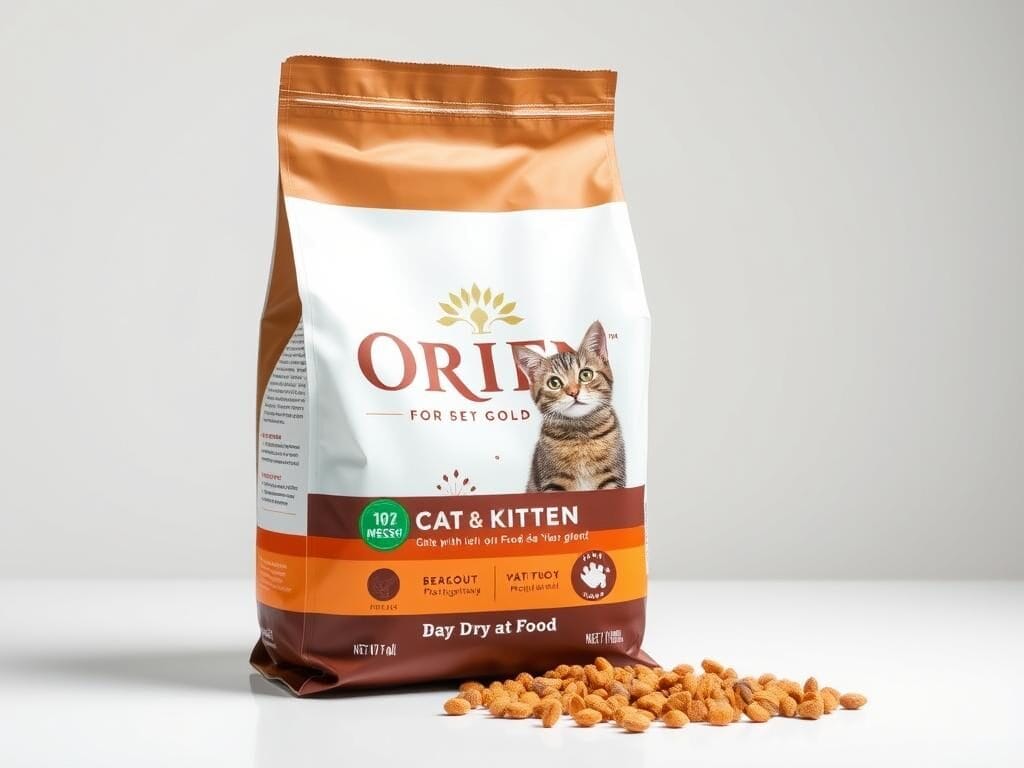
1. Orijen Cat & Kitten Dry Cat Food
Orijen Cat & Kitten stands out with its impressive 40% protein content derived from quality animal sources. The formula includes fresh and raw animal ingredients (85% total) from free-run chicken and turkey, wild-caught fish, and cage-free eggs.
Pros
- First five ingredients are all quality animal proteins
- Contains nutrient-rich organ meats
- Free from artificial preservatives and fillers
- Appropriate for all life stages
Cons
- Premium price point
- Contains some legumes
- May be too rich for sensitive stomachs
Best for: Cat owners who prioritize high protein content and ingredient quality, and are willing to pay a premium price for biologically appropriate nutrition.

2. Blue Buffalo Wilderness High Protein
Blue Buffalo Wilderness offers a grain-free formula with 40% protein, inspired by the natural diet of wild cats. Deboned chicken is the first ingredient, supported by chicken meal and turkey meal for concentrated protein sources.
Pros
- High protein content from quality animal sources
- Contains LifeSource Bits with antioxidants, vitamins, and minerals
- No by-product meals, corn, wheat, or soy
- More affordable than some premium options
Cons
- Contains peas and tapioca starch as binders
- Some cats may not like the texture of LifeSource Bits
- Higher carbohydrate content than some competitors
Best for: Pet parents seeking a balance between high protein content and affordability, especially for active adult cats.

3. Hill’s Science Diet Adult Indoor
Hill’s Science Diet Adult Indoor is specifically formulated for indoor cats, with controlled calories to help maintain ideal weight. Chicken is the first ingredient, and the formula includes natural fibers to reduce hairballs—a common issue for indoor cats.
Pros
- Formulated specifically for indoor cats’ needs
- Contains natural fiber for hairball control
- Balanced minerals for urinary health
- Highly digestible ingredients
Cons
- Lower protein content than some competitors (29%)
- Contains some grain fillers
- Not suitable for grain-sensitive cats
Best for: Indoor cats prone to weight gain and hairballs, especially in multi-cat households where a reliable, veterinarian-recommended option is preferred.

4. Purina Pro Plan LiveClear
Purina Pro Plan LiveClear offers a unique benefit: it’s the first cat food shown to reduce cat allergens in hair and dander by an average of 47% starting in the third week of daily feeding. Beyond this innovative feature, it provides quality nutrition with chicken as the first ingredient.
Pros
- Reduces allergens that can cause sensitivities in humans
- Contains real chicken as the first ingredient
- Includes prebiotic fiber for digestive health
- Formulated with targeted nutrition for specific needs
Cons
- Higher price point than standard cat foods
- Contains some grain by-products
- Some cats may not prefer the taste
Best for: Households with mild to moderate cat allergies who don’t want to give up their feline companions, and cats who thrive on chicken-based protein.

5. Kirkland Signature Maintenance Cat
Kirkland Signature offers exceptional value without compromising significantly on quality. With chicken and chicken meal as the first ingredients, it provides 30% protein content at a fraction of the cost of premium brands. The formula includes probiotics for digestive health and omega fatty acids for skin and coat health.
Pros
- Excellent value for money
- No artificial colors, flavors, or preservatives
- Contains probiotics for digestive health
- Includes omega fatty acids for skin and coat
Cons
- Contains some grain fillers
- Only available at Costco or through select online retailers
- Not specialized for specific health conditions
Best for: Budget-conscious cat owners who still want to provide quality nutrition without artificial additives, especially in multi-cat households.
Nutritional Comparison of Top Dry Cat Foods
| Brand | Protein | Fat | Fiber | First 3 Ingredients | Special Features | Price Range |
| Orijen Cat & Kitten | 40% | 20% | 3% | Chicken, Turkey, Whole Mackerel | 85% animal ingredients, freeze-dried liver | $$$ |
| Blue Buffalo Wilderness | 40% | 18% | 4% | Deboned Chicken, Chicken Meal, Pea Protein | LifeSource Bits, grain-free | $$ |
| Hill’s Science Diet Indoor | 29% | 16% | 7% | Chicken, Whole Grain Wheat, Corn Gluten Meal | Hairball control, urinary health | $$ |
| Purina Pro Plan LiveClear | 34% | 16% | 5% | Chicken, Rice, Corn Gluten Meal | Reduces cat allergens, prebiotics | $$$ |
| Kirkland Signature | 30% | 20% | 3% | Chicken, Chicken Meal, Whole Grain Brown Rice | Probiotics, no artificial additives | $ |
This comparison highlights the nutritional differences between our top picks. Higher protein options like Orijen and Blue Buffalo Wilderness are ideal for active cats, while specialized formulas like Hill’s Science Diet Indoor address specific needs like hairball control. Budget-friendly Kirkland Signature offers solid nutrition at an excellent price point.
Comprehensive Buying Guide: Finding the Best Dry Cat Food

Considering Your Cat’s Age and Life Stage
Cats have different nutritional needs at various life stages. Kittens require more calories, protein, and certain nutrients like DHA for brain development. Adult cats need balanced nutrition for maintenance, while senior cats (typically 7+ years) often benefit from adjusted phosphorus levels and joint support supplements. Always choose a formula specifically designed for your cat’s life stage.
Addressing Health Conditions Through Diet
Many common feline health issues can be managed through appropriate nutrition:
- Weight Management: Overweight cats benefit from reduced-calorie formulas with higher protein to maintain muscle mass while losing fat.
- Urinary Health: Cats prone to urinary issues may need foods with controlled mineral levels, particularly magnesium and phosphorus.
- Sensitive Digestion: Limited ingredient diets or those with added prebiotics and probiotics can help cats with digestive sensitivities.
- Hairball Control: Formulas with added fiber help hairballs pass through the digestive system.
Understanding Flavor Preferences
Cats can be notoriously picky eaters. Some prefer poultry flavors like chicken or turkey, while others might favor fish-based formulas. If your cat shows little interest in their food, try rotating between different protein sources. However, make transitions gradually to avoid digestive upset. Some cats also prefer smaller kibble sizes or certain textures, so consider these factors when selecting a food.
Budget Considerations Without Compromising Quality
Quality nutrition doesn’t always require the most expensive food. Mid-range options like Blue Buffalo Wilderness offer excellent nutrition at a reasonable price point, while budget options like Kirkland Signature provide surprisingly good quality for the cost. Consider cost per serving rather than just package price—more nutrient-dense foods may require smaller portions, making them more economical than they initially appear.
Veterinarian Recommendations and Insights
“When evaluating dry cat food, I look for named animal proteins as the first ingredients, appropriate AAFCO certification for life stage, and the absence of artificial preservatives. While grain-free diets have become popular, there’s no scientific evidence that they’re better for most cats unless there’s a specific grain allergy.”
Veterinarians emphasize several key points when discussing dry cat food options with pet owners:
- AAFCO certification is essential to ensure complete and balanced nutrition
- Protein content should be at least 30% for adult cats, with higher levels (35-40%) for kittens and active cats
- Hydration is crucial—even with dry food, cats should have constant access to fresh water
- Rotating between different protein sources can help prevent food sensitivities
- Prescription diets are valuable for managing specific health conditions but should only be used under veterinary guidance
Many veterinarians recommend a combination feeding approach—using both wet and dry food—to provide nutritional benefits while supporting hydration. This approach can be particularly beneficial for cats prone to urinary issues or those who don’t drink enough water on their own.
What Cat Owners Are Saying: Customer Reviews
“After switching to Orijen, my 7-year-old Maine Coon’s coat became noticeably shinier, and he seems more energetic during playtime. Yes, it’s expensive, but the improvement in his overall health makes it worth every penny.”
“My two cats have been on Hill’s Science Diet Indoor for years. It’s helped tremendously with hairball issues, and they maintain healthy weights. The price is reasonable for the quality, especially when buying the larger bags.”
“Kirkland Signature has been a game-changer for our multi-cat household. All four cats love it, their coats look great, and we’re saving a significant amount compared to the premium brand we used previously.”
“The Purina Pro Plan LiveClear has made a noticeable difference in my husband’s cat allergies. He can now spend time in the same room as our cat without constant sneezing. Our cat transitioned to it easily and seems to enjoy the taste.”
Customer experiences highlight that the “best” food often depends on individual cats’ needs and preferences. Many report improvements in coat quality, energy levels, and digestive health after switching to higher-quality options. Budget-conscious owners frequently mention Kirkland Signature as providing excellent value, while those with specific health concerns appreciate specialized formulas like Hill’s Science Diet and Purina Pro Plan.
Frequently Asked Questions About Dry Cat Food
Is dry cat food better than wet food?
Neither is inherently “better”—both have advantages. Dry food is convenient, economical, and helps with dental health, while wet food provides hydration and is often more palatable. Many veterinarians recommend a combination of both to maximize benefits. Cats with certain health conditions like urinary issues or diabetes may benefit more from wet food’s moisture content.
How much dry food should I feed my cat daily?
Feeding guidelines vary based on your cat’s weight, age, activity level, and metabolism. As a general rule, an average 10-pound adult cat needs about 200-250 calories daily. Most dry foods provide feeding guidelines on the packaging based on weight. Start with the recommended amount, then adjust based on your cat’s body condition. If your cat is gaining unwanted weight, reduce portions slightly; if losing weight unintentionally, increase portions.
Are grain-free dry cat foods healthier?
Not necessarily. While grain-free foods are marketed as more natural for cats, there’s no scientific evidence that grains are harmful to most cats. In fact, some grain-free foods substitute ingredients like potatoes or legumes that may provide less nutritional value than whole grains. Unless your cat has a diagnosed grain allergy (which is rare), focus more on overall ingredient quality and appropriate nutrient levels rather than whether a food contains grains.
How long does dry cat food stay fresh after opening?
Most dry cat foods remain fresh for about 4-6 weeks after opening, assuming proper storage. Store dry food in its original bag (which has protective linings) inside an airtight container in a cool, dry place. Avoid transferring food directly into containers, as this can lead to nutrient degradation and fat oxidation. Always check for signs of spoilage like off odors, mold, or pest infestation.
Should I switch my cat’s food regularly or stick with one formula?
There are benefits to both approaches. Rotating between different protein sources can help prevent food sensitivities and provide varied nutrients. However, some cats with sensitive stomachs do better with consistency. If you choose to rotate foods, do so gradually by mixing increasing amounts of the new food with decreasing amounts of the old food over 7-10 days to prevent digestive upset.
Conclusion: Making the Best Choice for Your Cat
Finding the best dry cat food involves balancing nutritional quality, your cat’s specific needs, and your budget. Our top recommendations provide options across different price points and nutritional profiles to help you make an informed decision.
Remember that the “best” food is ultimately the one that keeps your cat healthy, maintains an ideal body condition, and results in good energy levels, a shiny coat, and normal digestion. Monitor your cat’s response to any food and be willing to adjust as needed.
For optimal feline health, consider complementing dry food with wet food for hydration, ensure fresh water is always available, and schedule regular veterinary check-ups to monitor your cat’s overall health and adjust their diet as needed throughout their life stages.
Ready to upgrade your cat’s nutrition?
Choose from our top-recommended dry cat foods to provide your feline friend with the quality nutrition they deserve.



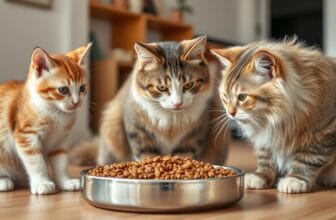
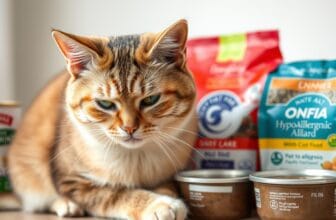
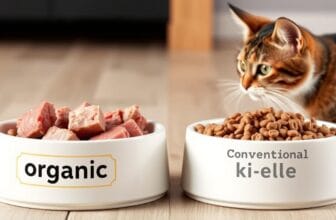
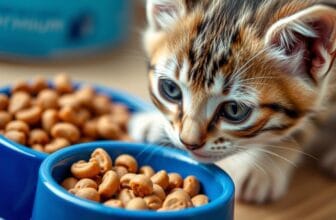

[…] Dry cat food has some big benefits: […]
[…] cat food properly is key to keeping it fresh and safe. Fresh cat food is different from dry kibble. It needs special care to keep its nutrients and stop bacteria from […]
[…] dry cat food in a cool, dry […]
[…] picking dry cat food, choose high-quality brands that follow AAFCO standards. These foods ensure your cat gets all the […]
[…] and dry cat foods are different. Wet food has about 70% water, while dry food has about 10%. This difference affects […]